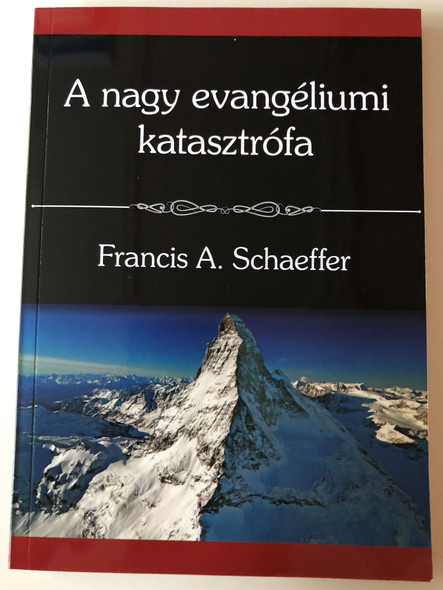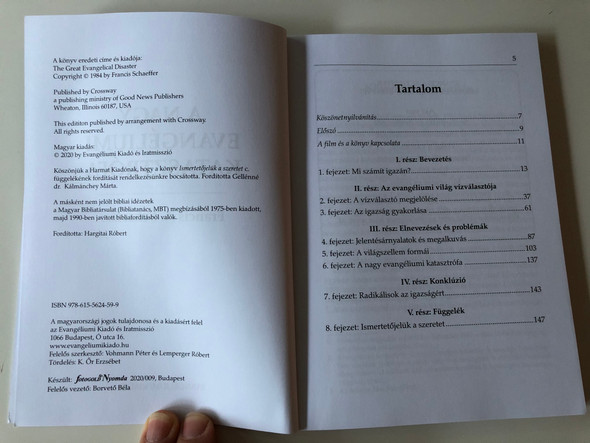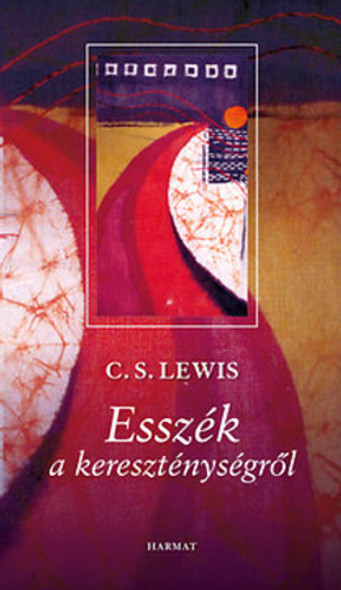Description
Evangéliumi beszélő képek
Paperback
ISBN: 9639209716
Pages: 368
Publisher: EVANGÉLIUMI
Overview
Hungarian:
Az Evangéliumi beszélő képek egy olyan gyűjtemény, amely képeken és metaforákon keresztül adja át az evangélikus körök nyelvezetét. A könyv bemutatja a keresztény üzeneteket és vallási tanításokat könnyen érthető, vizuális formában, különös figyelmet szentelve a vallásos humor és üzenetek szellemes, mégis mély hatású ábrázolásának.
English:
Christian Cartoons is a collection of pictures and metaphors used in the language of evangelical circles. The book presents Christian messages and religious teachings in an easy-to-understand, visual format, with particular emphasis on the clever and deep portrayal of religious humor and messages.
About the Author
Hungarian:
Dr. Ernest James Pace (USA) a keresztény képregények egyik korai úttörője. 1880-ban született Columbusban, Ohio államban. Művészi tehetségét először egy újságíró fedezte fel, aki egy templomi szolgálat közben látta őt rajzolni, és bemutatta a helyi újság szerkesztőjének. Noha eredetileg a West Point katonai akadémián való tanulás volt a célja, végül olyan támogatást kapott az újságírói karikatúrákhoz, hogy tizenkilenc évesen Chicago-ba költözött, hogy a napi Journal-hoz illusztráljon.
English:
Dr. Ernest James Pace (USA) was one of the earliest American "Christian Comics Pioneers," born in Columbus, Ohio in 1880. Pace's artistic talent was first "discovered" by a news reporter who saw him sketching during a church service and introduced him to the editor of the local paper. His ambition to attend West Point was never realized, but the encouragement he received for his newspaper cartooning led him to move to Chicago at age nineteen to illustrate for the daily Journal.
Key Features
- Visual Evangelism: A unique approach to presenting Christian teachings through cartoons and illustrations, making complex ideas more accessible. Vizualitás az evangéliumban: Egyedülálló megközelítés a keresztény tanítások bemutatására karikatúrák és illusztrációk segítségével, amelyek megkönnyítik az összetett ötletek befogadását.
- Religious Humor: Incorporates light-hearted humor while delivering meaningful spiritual messages, making it suitable for all ages. Vallásos humor: Könnyed humorral ötvözi a mély vallási üzeneteket, így minden korosztály számára alkalmas olvasmány.
- Metaphoric Illustrations: The book features metaphors and visual stories that enhance understanding of evangelical beliefs. Metaforikus illusztrációk: A könyv olyan metaforákat és vizuális történeteket tartalmaz, amelyek segítik az evangélikus hit megértését.
Interesting Facts
- Early Christian Comics: Dr. Pace is considered one of the first artists to combine comics with Christian teaching, paving the way for a unique genre of Christian comics. Korai keresztény képregények: Dr. Pace az első művészek közé tartozik, akik ötvözték a képregényeket a keresztény tanítással, így egyedülálló műfajt teremtve a keresztény képregények világában.
- Cultural Influence: His works have inspired many in the field of religious illustration and visual storytelling. Kulturális hatás: Munkái sokakat inspiráltak a vallásos illusztrációk és vizuális történetmesélés területén.
Perfect for Christian Readers and Art Enthusiasts
This book is ideal for:
- Families: Offering a fun yet insightful way to engage children and adults with the principles of Christianity. Családoknak: Szórakoztató, mégis tanulságos módja annak, hogy gyermekeket és felnőtteket vonjunk be a kereszténység alapelveibe.
- Artists and Illustrators: Those interested in the intersection of art and Christian messages will find this book an inspiring read. Művészeknek és illusztrátoroknak: Azok számára, akik az művészet és a keresztény üzenetek metszéspontjában érdeklődnek, inspiráló olvasmány lehet.
- Church Groups: A great resource for church youth groups or Bible study groups, providing a different way to approach the Bible. Egyházi csoportoknak: Kiváló forrás egyházi ifjúsági csoportoknak vagy bibliai tanulmányozó csoportoknak, új megközelítést kínálva a Biblia tanulmányozásához.
Hashtags
#ChristianComics #EvangelicalCartoons #VallásosKépregények #KeresztényÜzenet #ErnestJamesPace #BibliaiHumor #VizuálisTanítás #KépregényÉsVallás
|
Dr. E. J. Pace (USA)
One of the earliest American "Christian Comics Pioneers" was Ernest James Pace, who was born in Columbus, Ohio USA in 1880. Pace's artistic talent was first "discovered" by a news reporter who saw him sketching during a church service and introduced him to the editor of the local paper. His ambition to be a West Pointer never realized, he nonetheless received such encouragement for his newspaper cartooning that, at age nineteen, he moved to Chicago to illustrate for the daily Journal. Pace later recalled, "But there in that great city I met Larsen, a Dane, whose beautiful Christian life and personal efforts won me to Christ. My conversion was of the revolutionary kind, positive and complete, like stepping out of a deep, dark cellar into the blazing light of the noonday. Naturally, I lost all interest in politics, and lost my job. At once I set about preparing for Christian work, and offered some drawings for Frank Beard, famous cartoonist of The Ram's Horn. He accepted one, but redrew it in colors and published it on the cover."
Exposed to the growing Modernism of his day through the popular media and perhaps even his Seminary, Pace had become unconsciously influenced by it. A "loving rebuke" from fellow missionary Julia Mott Hodge in February 1914 affected him profoundly and, after much personal misery, many tears, and fervent prayer, he rededicated himself and his work to the Lord. He wrote Miss Hodge later (in 1934) that, "the dear Lord took his erring child again into His bosom, and oh, what a transport of joy, what cleanness of soul was mine by the blessed effusion of His Spirit. It seemed I had had an inward bath; every nook and cranny of my being was every whit made clean. God turned my captivity, and springs of water made glad the desolate desert of my soul. That was March, 1914, and from that day to this, Modernism has had no more influence over me than to awaken a burning hatred of it."
"Then it was," Pace wrote, "that the doctors declared that I had 'tropical sprue,' and that I must return to the United States at once if I wished to avoid a trip to the cemetery. (Editor's Note: Tropical sprue is a digestive problem that occurs in the tropics and subtropics.) "On returning to the States, I recovered my health on strawberries and milk as a diet, and plenty of rest and warm sunshine on the shores of beautiful Lake Chautauqua in New York.
"During this time I spent a day in the woods in prayer, and it was a time of unspeakable blessing and nearness of approach to God. I was given boldness to make very definite requests, one of which was: 'I want, Lord, a world-wide ministry. I know I am far from worthy of it, but that makes no difference. Grace ignores both worthiness and unworthiness, and, please God, I'm "under grace".'" It was only a month or two at most when He began to answer that prayer, first by Pace's meeting with Dr. C. G. Trumbull, editor of THE SUNDAY SCHOOL TIMES, a respected Christian journal whose weekly circulation was over 100,000 in the United States and abroad. It was then and there that Trumbull engaged Pace to produce cartoons to coincide with the Sunday School lessons printed on the same page. The first appeared on the 2nd of December, 1916, and the TIMES would run his cartoons weekly for the next thirty years.

In 1922 highlights from the first six years of his cartoons for THE SUNDAY SCHOOL TIMES were reprinted as a book entitled, aptly, CHRISTIAN CARTOONS. This 96 page volume was published simultaneously by the Bible Institute Colportage Association (later Moody Press) in Chicago and by the Sunday School Times Co. in Philadelphia. The introduction to this book states that the cartoons emphasize "...first the supreme value of God's Word and the importance of Bible study, the simple truths of the Gospel are then introduced, showing that there is salvation through Christ only, and that neither character nor education, feelings nor fitness, Christian Science, civilization, nor even prohibition, are in any way sufficient. All men are sinners, but there is salvation for all through the shed blood of Christ and that alone. "In contrast there follow pictures for leaders who do not teach this, warnings concerning worldliness, and the mirror is held up to the various faults of men. But there is forgiveness, and there follow the precious lessons of faith, prayer, and obedience. Powerful messages on soul-winning, the call of missions, the Victorious Life, and the Second Coming of Christ complete the series..."
 has revealed Himself so gloriously in creation, and so compassionately in redemption, has left His 'watermark', so to speak, upon the pages of both His world and His word, attesting the fact of His triune nature..." has revealed Himself so gloriously in creation, and so compassionately in redemption, has left His 'watermark', so to speak, upon the pages of both His world and His word, attesting the fact of His triune nature..."
His cartoons also appeared in the book SEVEN QUESTIONS IN DISPUTE by the famous Christian orator and 3-time Presidential candidate William Jennings Bryan in 1924, just a year before Bryan represented the Biblical Creationist view in the famous 'Scopes Monkey Trial.' In the mid- to late-1920s Dr. Pace and a dozen or more Christian ministers vigorously sought to establish a rest home for missionaries on furlough which could also be used as a Bible conference centre. Though a location near Pace's Orlando, Florida residence was selected, a board of directors put in place, the property purchased, and significant financial backing acquired, it was not to be, due to circumstances which are not entirely clear. It's possible that the 1926 hurricane, which destroyed Miami and brought about the end of the Florida Land Boom, was part of the cause. Whatever the reason, the conference center's failure may have been a blessing in disguise, considering the approaching stock market crash of 1929 and ensuing Depression which gripped the United States until its entry into World War II. The Bible Institute Colportage Association published "Settling the Big Question" in 1926, a small tract booklet illustrated by Dr. Pace, which was reprinted even into the 1930s (when the publisher's name was changed to Moody Press). They also released PICTURES THAT TALK Vol. 1 and 2, as a follow-up to CHRISTIAN CARTOONS, in 1929.
In 1936 Fundamental Truth Publishers in Findlay, Ohio published LIFE BEGINS AT...? Pace's art at this time had become more polished and refined, his pen-and-ink rendering and calligraphy resembling the 'engraved' style of his secular counterpart Franklin Booth, or Winsor McCay who illustrated for the Hearst Syndicate. In the introduction of LIFE BEGINS AT...? (full title: LIFE BEGINS AT THE MOMENT YOU RECEIVE THE LORD JESUS CHRIST AS YOUR SAVIOUR AND YOUR SOVEREIGN) editor Trumbull writes that Pace's drawings have been distributed "...to every state and province of North America and more than one hundred foreign countries and mission fields. These cartoons have been published also as tracts, posters, lantern slides, and in book form, and have been eagerly welcomed and widely used. Exemplifying the widespread effect of Pace's cartoons are the following two (of innumerable) cases. Pace himself shared the first: "I encountered a man in London, just over from France, who had 121 of my cartoons greatly enlarged, done in colors and rendered into French. And he has, for years, been travelling up and down France, holding meetings on street corners of French villages, displaying the pictures and preaching the Gospel." The second was from a missionary to the Belgian Congo, Africa in 1935: "My personal boy has a burning desire to beautify his house by papering it with such pictures... one had a cartoon of Dr. Pace representing the cigarette as walking off with a man chained up by the nose... 'Yes, mama,' he replied, 'I look at that picture all the time, and every day it puts the fear into my heart against those cigarettes and against all tobacco. It says we are the temple of the Holy Spirit...' Our mission is not yet troubled by our native Christians smoking and drinking... We do want to teach our own boys the ill effect of tobacco and drink, and give them a desire to try to be as strong and healthy and clean for the Lord as is possible..."
At this time Dr. Pace had been an instructor at the Hampden DuBose Academy, a Christian school in Orlando, Florida. Author/lecturer Elisabeth Elliot, best known for her pioneering missionary work amongst the Auca Indians in South America, wrote: "When I was a high school student in Orlando, Florida, Dr. E. J. Pace would sometimes visit the school, to our great delight, sketching pictures which depicted Gospel truths. He was a friend not only of my Uncle Charley (C.G. Trumbull) but of my father, Philip E. Howard Jr. ... It was mesmerizing to watch him draw a cartoon in a few minutes, then he would explain what he had drawn, always referring to the Scriptures..."
I have come up here to Columbus to get treatments from my brother-in-law who has had great success with stroke cases. Although we've been here but two weeks, there are already indications of improvement. So I am abounding in hope through the power of the Holy Ghost."
In June, 1946 Dr. Pace and his wife had gone to Hendersonville, North Carolina where they had planned to spend the summer. On early Wednesday, the 19th of June, Dr. Pace went to be with the Lord. He was sixty-six years old. A book called HOW TO BE FILLED WITH THE SPIRIT, written by James W. Elliott, with Pace cartoons from THE SUNDAY SCHOOL TIMES, was published after Dr. Pace's death, in 1946.
In his obituary, THE SUNDAY SCHOOL TIMES reported: "...More than fifteen hundred of Dr. Pace's cartoons have appeared in the TIMES since the first one was published December 2, 1916. Many hundreds, perhaps thousands, were reproduced in tract and poster form, and they have become known throughout the world. Missionaries have redrawn them for their people, translating Dr. Pace's explanations into the native languages. They have doubtless been the means of leading multitudes to a saving knowledge of the Lord Jesus Christ, bringing backsliders into renewed fellowship with God, and building up Christians in the faith. The blessings of these cartoons are incalculable.
|
|||||||||||
|
|
Hungarian Summary:
Az evangéliumi nyelvezetben használt képek, metafórák rajzos, magyarázatos gyűjteménye.
English Summary:
A collection of pictures and metaphors used in the language of evangelical circles.









 On 6 July, 1940 the TIMES reported that E. J. Pace suffered from what was most likely a stroke, and almost died. Though his eyesight and physical strength did eventually return, it became necessary for him to draw his TIMEScartoons at a much larger size. From April till September, 1940 Pace's cartoon ideas were drawn by
On 6 July, 1940 the TIMES reported that E. J. Pace suffered from what was most likely a stroke, and almost died. Though his eyesight and physical strength did eventually return, it became necessary for him to draw his TIMEScartoons at a much larger size. From April till September, 1940 Pace's cartoon ideas were drawn by 



















